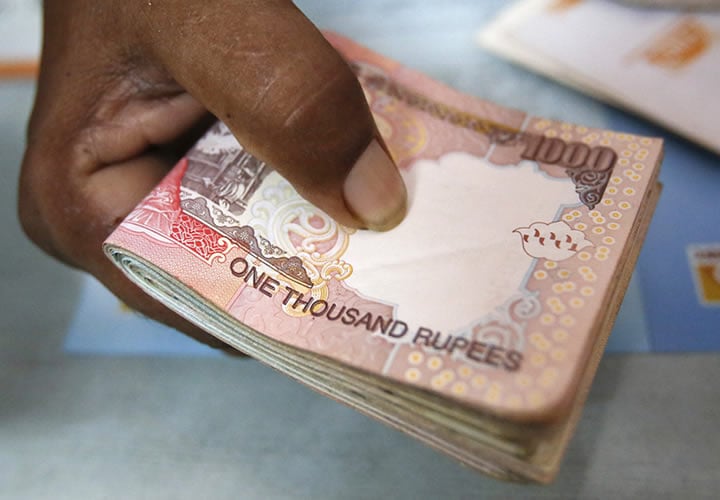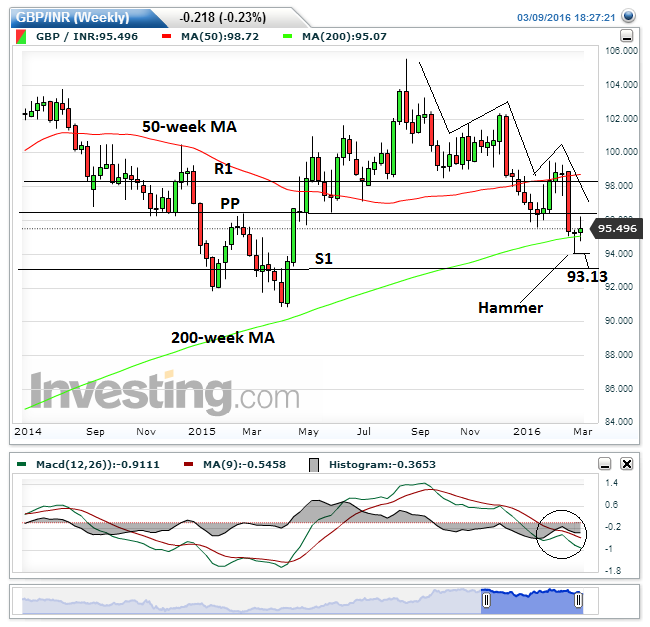Indian Rupee to lead Emerging Market FX Higher, Pound Finds Support for Now

The Indian rupee is likely to strengthen in the short-term according to analysts at HSBC.
- “We believe the INR, IDR, TRY and MXN are the best currencies with which to express a bullish EM FX view.” - analyst David Bloom
- Pound to rupee exchange rate reaches support provided by the 200-week moving average
India's rupee (INR) is expected to see a rise in the short-term as several factors holding back emerging market (EM) foreign exchange loosen their grip allowing currencies such as INR to rebound.
Those with the strongest domestic economies are most likely to have the strongest upside potential, according to a note issued by HSBC.
India has the fastest growing economy in the world and an increasingly diversified economy, which is not solely reliant on one specific commodity or sector.
This dynamic enhances the prospects for the the rupee as the tide turns in favour of emergin market currencies.
Pressures on Emerging Market Foreign Exchange Lifting
EM currencies had been weighed down by two main factors – the dollar’s strength due to Fed rate hike expectations, and China slow-down fears, which bred Global slow-down concerns and universal uncertainty.
HSBC's Global Head of FX Strategy David Bloom, who co-authored the note, argues that these twin pressures have eased significantly allowing scope for EM FX gains:
“The two key factors which converged on selling EM FX – the USD bull run and immediate China concerns − are fading.”
Adding:
“We believe the INR, IDR, TRY and MXN are the best currencies with which to express a bullish EM FX view.”
Bloom, says that markets have moved from “fear to acceptance,” in relation to China slow-down concerns:
“Yes, growth is slower than in the past, but it is showing early signs of stabilisation, which may support commodity prices.”
On fears of renminbi devaluation - which so rocked markets in January - he says familiarity has inured markets:
“Meanwhile, the market has become more used to RMB volatility. Concerns about a sharp devaluation of the RMB are disappearing.”
As far as the Fed goes, he argues that lessening hike expectations have reduced concern over rising borrowing costs:
“The market is a lot less concerned about Fed rate hikes. The expected pace of hikes has been pushed back significantly, with less than a 50% chance of a hike by June priced into the rates market. So concerns about the cost of capital rising sharply and hurting EM FX are less acute. In the short-term he sees these as creating an opportunity for an EM currency backlash.”
Improving U.S data has created the perfect balance of economic growth and low interest rates which are likely to raise short-term borrowing costs as Fed hike expectations renew, but should chasten long-term borrowing costs, which will ease concern for EM debtors:
“So EM FX can benefit from low long-term funding costs, but with the US economy still providing support for global growth. We have previously argued that such a scenario of stronger US growth coupled with still soft inflation would be a positive signal for EM.”
Chart Forecast for Pound to Indian Rupee
The pound to rupee has fallen in recent months to its current level at 95.50.
Whilst the short-term trend remains down the pair has reached major support from the 200-week moving average and the 50-month moving average.
These two levels are calculated by averaging the price over the given period ie 50 or 200 months or weeks.
They provide lots of support for prices which are falling, or resistance to prices which are rising.

On the weekly chart the rate has formed a bullish hammer on the 200-week MA increasing the support potential of the level and heightening the possibility of a bounce in the very short term.
Upside is capped, however, by the monthly pivot at 96.33, so we see upside as temporary only, before the rate begins declining once more.
Monthly pivots are levels calculated using the previous months High, Low, Close and Open, and are often used by traders as areas to buy or sell; they therefore have great support or resistance potential and process often stall or are repelled by them.
The previous bearish, long, red, down week indicates the potential for even more downside, with a move below the hammer lows and the 94.00 handle confirming a move down to the S1 monthly pivot at 93.13.




